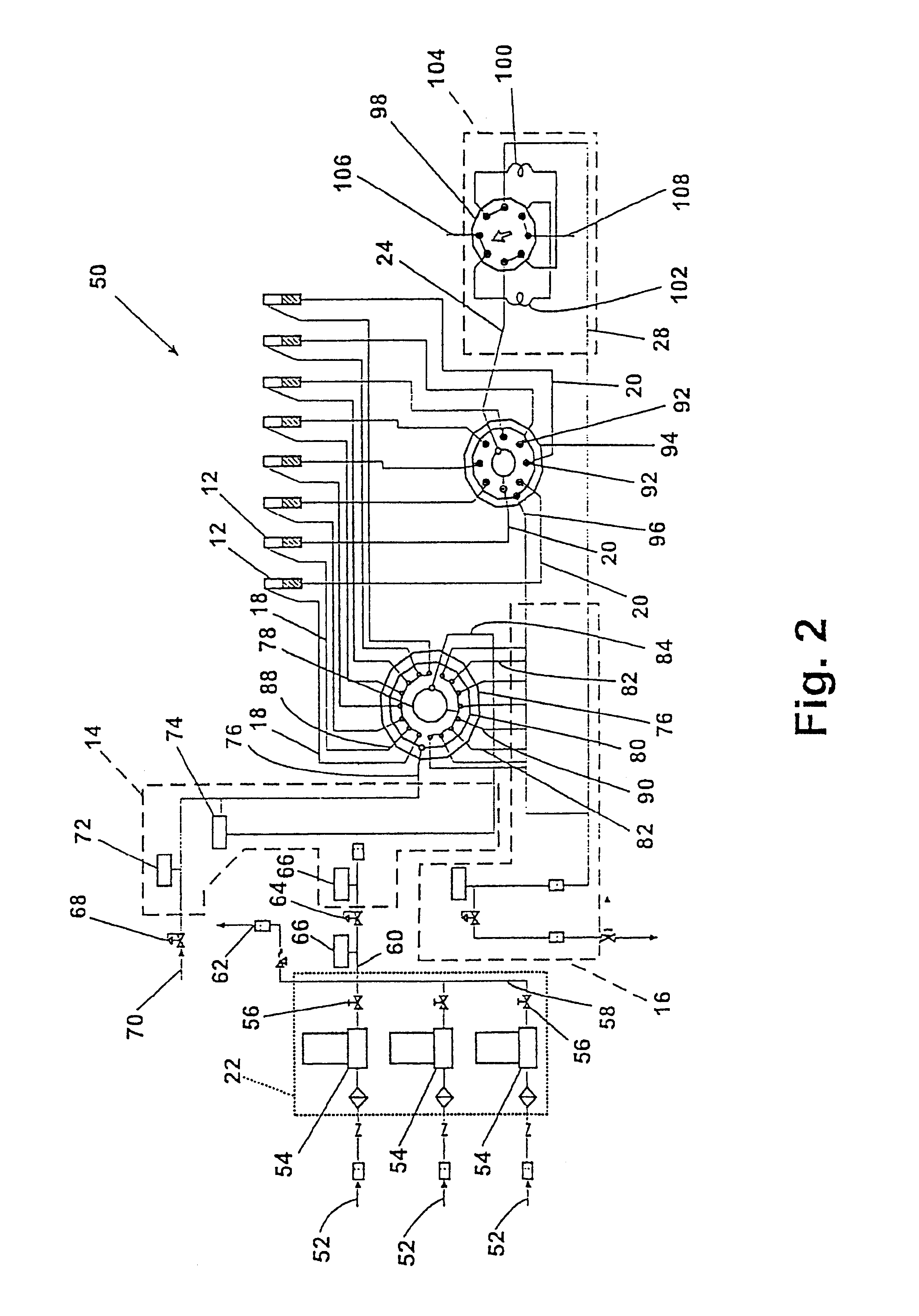Methods for screening catalysts in a parallel fixed-bed reactor
a technology of fixed-bed reactor and catalyst, which is applied in the direction of chemical analysis using combustion, liquid-gas reaction process, chemical/physical process, etc., can solve the problems of not being able existing analytical methods and devices, and being unable to meet the requirements of combinatorial library screening, etc. researchers have expended little effort to speed up the screening step
- Summary
- Abstract
- Description
- Claims
- Application Information
AI Technical Summary
Benefits of technology
Problems solved by technology
Method used
Image
Examples
example 1
Flow Matching
FIG. 13 schematically shows flow paths for the fluid handling system illustrated in FIG. 2. The selection valve 94 in FIG. 13 diverts fluid into two groups of fluid streams: a first flow path 320, which includes the sample bypass 24, sampling valve 98, first metering tube 100, and return line 28, and a second flow path 322, which vents fluid directly into the exit control volume 16 via the common exhaust port 96.
Table 1 lists conductance for each segment of the two flow paths based on air at standard temperature and pressure. Conductance for the selection valve 94 and the sampling valve 98, an 8-port injection valve, were calculated from data obtained from the manufacturer, VALCO, for valves having {fraction (1 / 16)} inch fittings and 0.030 inch diameter bore size. According to VALCO, applying air at 5 psig results across either valve results in a flux of 1000 atm·ml·min−1, which corresponds to a one-pass conductance of 1000·14.7 / 5 ml·min−1 or 3000 ml·min−1. The conducta...
example 2
Screening Methodology Using 48-Vessel Screening Apparatus
FIG. 14 shows gas distribution and temperature control as a function of time for the 48-vessel screening apparatus 10 shown in FIG. 1. The 48-vessel screening apparatus uses a fluid handling system, vessel assembly, and temperature control system like those shown in FIG. 2, FIG. 8-10, and FIG. 11, respectively. The vessels are arranged in eight rows, each of the rows having six vessels. Thus, the eight vessels 12 shown in FIG. 2 correspond to the first of six vessels of each row. Furthermore, flow restrictors 18 connect each of the first outlet ports 88 to the other five vessels (not shown) in each row. In this way, fluid flows from a single outlet port 88 to all six vessels of a particular row simultaneously.
Row-by-row contacting is shown schematically in FIG. 14. Vertical lines 340 indicate the time at which the distribution valve 76 of FIG. 2 starts to provide test fluid to a particular row of vessels. First horizontal line...
example 3
Catalyst Screening
A six-vessel screening apparatus was used to screen library members based on their ability to catalyze the conversion of ethane to ethylene. The apparatus employed fluid handling and temperature control systems similar to those shown in FIG. 2, and FIG. 11, respectively. Furthermore, the screening apparatus comprised one base segment 154 of the vessel assembly 150 shown in FIG. 8.
High purity ethane and 14.4% O2 in N2 were obtained from MATHESON. Pure N2 was obtained from an in-house supply line. After loading catalysts, the fluid handling system was purged for ten minutes with N2 to remove O2. Next, the fluid handling system was filled with ethane for another ten minutes. GC detection was carried out to ensure that the ethane level had reached 95%. The O2 / N2 mixture was then added so that the reactant flow rate was 1.04 sccm per reactor vessel, and the gas composition was 40% ethane, 8.6% O2, and 51.4% N2. The stability of gas flow was measured periodically by GC.
T...
PUM
| Property | Measurement | Unit |
|---|---|---|
| temperatures | aaaaa | aaaaa |
| temperatures | aaaaa | aaaaa |
| contact time | aaaaa | aaaaa |
Abstract
Description
Claims
Application Information
 Login to View More
Login to View More - R&D
- Intellectual Property
- Life Sciences
- Materials
- Tech Scout
- Unparalleled Data Quality
- Higher Quality Content
- 60% Fewer Hallucinations
Browse by: Latest US Patents, China's latest patents, Technical Efficacy Thesaurus, Application Domain, Technology Topic, Popular Technical Reports.
© 2025 PatSnap. All rights reserved.Legal|Privacy policy|Modern Slavery Act Transparency Statement|Sitemap|About US| Contact US: help@patsnap.com



